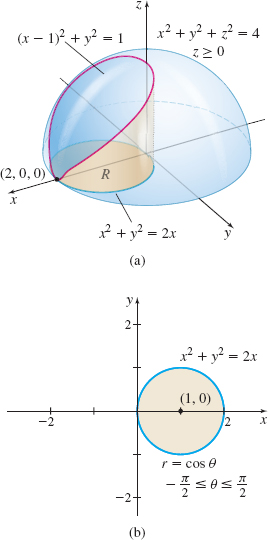EXAMPLE 3Finding the Volume of a Solid Using Cylindrical Coordinates
Find the volume of the solid enclosed by the hemisphere x2+y2+z2=4, z≥0, and the cylinder (x−1)2+y2=1.
Solution Figure 56(a) shows the hemisphere and the part of the cylinder whose volume we seek.
Because x2+y2 appears in the equation of both the hemisphere and cylinder, we use cylindrical coordinates. The equation of the hemisphere is Rectangular Coordinates:x2+y2+z2=4,z≥0Cylindrical Coordinates:r2+z2=4,z≥0, or equivalently, z=√4−r2
The equation of the region in the xy-plane above which the surface lies is given by: Rectangular Coordinates:(x−1)2+y2=1x2+y2=2xCylindrical Coordinates:r2=2(rcosθ)−π2≤θ≤π2r=2cosθ
See Figure 56(b).
The solid E whose volume we seek is given by 0≤z≤√4−r2, 0≤r≤2cosθ, and −π2≤θ≤π2. The volume V of the solid is V=∭
